Gordonstoun
Gordonstoun School is a co-educational independent school (a public school in the British usage of the term) for boarding and day pupils in Moray, Scotland. It is named after the 150-acre (61 ha) estate owned by Sir Robert Gordon in the 17th century; the school now uses this estate as its campus. It is located in Duffus to the north-west of Elgin.[1] The school uses the Common Entrance Exam for entry at age 13+.
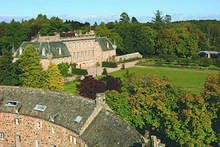
| Gordonstoun School | |
|---|---|
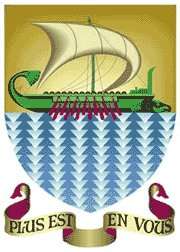 | |
| Address | |
Gordonstoun Road , , IV30 5RF Scotland , United Kingdom | |
| Coordinates | 57°42′15″N 3°22′18″W |
| Information | |
| Type | Public School Independent boarding school |
| Motto | Plus est en vous (More is in you!) |
| Religious affiliation(s) | Inter-denominational |
| Established | 1934 |
| Founder | Kurt Hahn |
| Local authority | Scottish Council for Independent Schools |
| Chairman of Governors | Catherine Eve Poole |
| Principal | Lisa Kerr |
| Chaplain | Philip Schonken |
| Staff | ~120 |
| Gender | Coeducational |
| Age | 13 to 19 |
| Enrollment | 518 |
| Houses | 8 boarding |
| Colour(s) | |
| Publication | The Gordonstoun Record |
| Former pupils | Old Gordonstounians |
| Website | http://www.gordonstoun.org.uk |
Founded in 1934 by German educator Kurt Hahn, Gordonstoun has an enrollment of around 500 full boarders as well as about 100 day pupils between the ages of 6 and 18.[2] With the number of teaching staff exceeding 100; there is a low student-teacher ratio compared to the average in the United Kingdom.[3] There are eight boarding houses (formerly nine prior to the closure of Altyre house in summer 2016) including two 17th-century buildings that were part of the original estate. The other houses have been built or modified since the school was established.
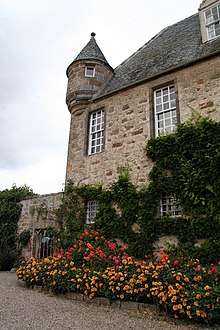
Gordonstoun has some notable alumni.[4] Three generations of British royalty were educated at Gordonstoun, including the Duke of Edinburgh and the Prince of Wales.[5] Due to Hahn's influence, the school has had a strong connection with Germany. It is part of the Round Square Conference of Schools, a group of more than 80 schools across the globe based on the teaching of Hahn. Around 30% of students attending Gordonstoun come from abroad.[6]
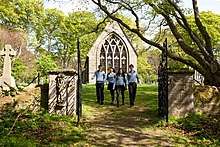
History
The British Salem School of Gordonstoun was established in 1934 by Kurt Hahn after he was asked by friends to give a demonstration in the UK of his "Salem system".[7] He was born in Berlin in 1886 and studied at the University of Oxford.[8] After reading Plato's The Republic as a young man, Hahn conceived the idea of a modern school. With the help of Prince Max of Baden, he set up the Schule Schloss Salem in 1919.[9] After the First World War, both men decided that education was key in influencing the future. They developed Salem in order to develop its students as community leaders. By the 1930s Salem had already become a renowned school throughout Europe. In 1932, Hahn spoke out against the Nazis and was arrested in March 1933.
He was released and exiled to Britain in the same year through the influence of the Prime Minister, Ramsay MacDonald, who was familiar with Hahn's work.[10] At the urging of British friends, Hahn decided to start a new school in Morayshire.[11]
Gordonstoun was started in a small way and had financial difficulties in its early years. After the death in 1930 of Sir William Gordon-Cumming, 4th Baronet, his house at Gordonstoun was obtained by Kurt Hahn,[12] whose offer for the lease was accepted on 14 March 1934.[13] The buildings needed repair and renovation, and at the start of the first academic year, the school had only two enrolled pupils.[14] Hahn expected Gordonstoun to operate for only a few years, as an example of his vision. The number of pupils steadily increased, and some additional pupils transferred from Salem, including Prince Philip of Greece, now the Duke of Edinburgh. By the start of the Second World War, 135 boys were attending.[15]
In June 1940 the school was evacuated and the Gordonstoun estate was taken over by the army for use as barracks. The school was relocated temporarily to quarters in Aberdovey in Mid Wales[11] when Lord Davies, a parent of two pupils, allowed the school to use one of his houses. The buildings were insufficient, and finances and pupil numbers began to drop. In 1941 by Hahn and Lawrence Holt with the support of the Blue Funnel Line, founded Outward Bound, based on the educational approach of Gordonstoun.[16][17]
The school survived the war, pupil numbers increased again, and the school became well known throughout Wales and the Midlands.[18] Once the war ended, the school returned to the Gordonstoun estate.[19]
By the end of the 1940s, the school achieved its primary target of 250 pupils and continued growing in size.[20] It built dormitories on the estate, removing the need for maintaining a house in Altyre, Forres, many miles away from the main campus. Gordonstoun also developed its academic offerings. It arranged to admit poorer children from the surrounding areas, and to deepen the Outward Bound-type activities that were central to Hahn's system.[21] Skills in mountaineering and seamanship were always taught at the school. The introduction of the Moray Badge, from which the Duke of Edinburgh's Award was borrowed, expanded the types of physical challenges for students to conquer.[22]
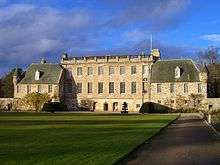
From the 1950s onwards, the school administration concentrated on improving the facilities and expanding the curriculum.[23] Major changes since then include: the founding of Round Square in 1966,[6] an international community of schools sharing Hahn's educational ideals; the school becoming co-educational in 1972;[24] and the moving of Aberlour House, Gordonstoun's preparatory school, from Speyside to a purpose-built Junior School[a] on campus in 2004.[25]
Ethos
In the beginning, Hahn blended a traditional private school ethos, modelled on his experiences at Eton and Oxford, with a philosophy inspired by Plato's The Republic and other elements of ancient Greek history.[26] This is seen in the title "Guardian", denoting the head boy and girl, the adoption of a Greek trireme as the school's emblem, and a routine that could be described as Spartan. Outdoor activities and skills such as seamanship and mountaineering are emphasized. The school had a reputation for harsh conditions, with cold showers and morning runs as a matter of routine. It also used physical punishments, known as "penalty drill" or PD, in the form of supervised runs around one's house (dormitory) or the south lawn of Gordonstoun House (pictured).[27] Physical education and challenging outdoor activities are still practised, but cold showers and punishment runs have been dropped.[28]
Hahn's views on education centred on the ability to understand different cultures. Gordonstoun incorporates this in a number of ways including its association with Round Square and in offering pupil exchanges to the different schools within the association. Additionally, there is a chance to join one of the annual international service projects which take pupils abroad to help a foreign community, for instance, there have been projects to build schools in Africa, build wells in Thailand and help orphans in Romania.[29] [30] Hahn believed that an important part of education was to challenge a person and take them out of their areas of familiarity and comfort, improving a person's ability to deal with difficult situations. The school requires that every pupil takes part in a series of outdoor programmes particularly expeditions in the Cairngorms and sailing training on the school's 80-foot vessel, Ocean Spirit.
Hahn believed that "The Platonic view of education is that a nation must do all it can to make the individual citizen discover his own power and further more that the individual becomes a cripple in his or her point of view if he is not qualified by education to serve the community."[31] The idea of service at the school is thought to encourage students to gain a feeling of responsibility to aid other people and is implemented in creating an array of services to the community in which every student becomes involved (see below).
Gordonstoun offers a series of grants, drawing on its investments and other funds, to support pupils who are unable to pay the full fees.[32] In the academic year 2009/10 the school provided financial support for 163 pupils including 11 with 100% fee coverage and 95 with 50% fee reduction.[33] The school is a registered charity: Scottish charity number SC037867.[34]
Gordonstoun Schools
Along with the main school, two other schools form part of the greater Gordonstoun community.[20] These are Gordonstoun's preparatory school, Aberlour House, and a summer school that serves to promote the school outside of the academic year.
Aberlour House
The first preparatory school was founded in 1936 at Wester Elchies and unlike Gordonstoun, was not made to move during the war. At the start of the war, there were 40 boys and girls attending, and these numbers increased to the point that a second school was opened at Aberlour House in 1947[25] by which time nearly 100 pupils were attending.[15]
Wester Elchies was pulled down in the early 1960s because of dilapidation. The prep school continued with just Aberlour, but even so, there were always problems with the 20 miles (32 km) that separated the main Gordonstoun campus and the school. In 2002 the running of Aberlour House was taken over by Gordonstoun, and in 2004 a purpose-built prep school was constructed on the main campus.[25] In January 2007, the disused Aberlour House became the head offices of Walkers Shortbread, whose main factory complex at Fisherton is adjacent to the house.
Presently Aberlour House has approximately 115 pupils between the ages of 6 and 13 attending.[35] Although they form part of the same institution, going to Aberlour is not a prerequisite for going to Gordonstoun and neither is it enforced that pupils at Aberlour House continue on into Gordonstoun.[25] They share the school song, flag and motto with Gordonstoun.[35]
Gordonstoun International Summer School
The Gordonstoun International Summer School started in 1976, it has catered to over 7,000 pupils since then.[36] It opens for a four-week period every summer with the aim of giving a taste of the Gordonstoun ethos. Although for the most part, the priority is adventure, sports and creative arts, the school also teaches courses in English. Around 250 children from all over the world between the ages of 8 and 16 attend each year.[37]
Academic curriculum
Entrance to Gordonstoun requires the pupil to pass the Common Entrance Examination.
In the Junior School (ages 8–13), pupils study a range of courses and follow the Scottish education system. In the Senior School (ages 13+) the pupils complete a year's foundation course and then enter into the English education system by starting a two-year GCSE course followed by a two-year A Level course.[30] Gordonstoun offers 21 GCSE courses, 27 AS Level courses and 21 A Level courses including specialised subjects such as Dance, Classical Studies and Further Mathematics.[32]
The 2019 Education Scotland inspection of Gordonstoun rated the school as ‘outstanding’ and ‘sector-leading’[38]
The 2009 HMIE inspection[39] evaluated Gordonstoun as being 'Excellent' in its curriculum.
96% of pupils proceed to higher education with 79% going to British universities and 17% to universities abroad. Of those who do not go on to further education many, take gap years or join the armed forces.[32]
Activities
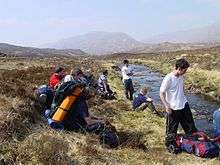
Sports
In the beginning, Hahn expressed his view that at many schools, ball games had been given precedence over other activities and so, to start with, more focus was placed on seamanship and practical work than the playing of games. Due to this, competitive matches did not start until 1935 when Gordonstoun played and won its first rugby match against Grantown Academy.[40] Even so, the school was still in its infancy, and there were no designated fields on which to play with conditions being so bad that during pre-match, half-time and post-match, players would clear as many pebbles off the field of play as possible.[40] 1935 saw Gordonstoun's cricket team win two, lose two and draw one.[41] Hahn set up the hockey team personally, with Prince Philip humorously recalling a game against Elgin Academy's ladies' team and saying that he "hoped that soon we shall be among the best Scottish girls' teams."[40]
As of 2013 there were playing fields for rugby, football and cricket as well as an outdoor hockey AstroTurf, outdoor tennis courts and a 400m running track. Apart from these outdoor pitches, there is a large sports centre with facilities that include a rock climbing wall, a 25m swimming pool, a weights room, squash courts and an indoor activity hall for basketball, badminton and netball.[42]
Aside from these more traditional sports, there is the opportunity to participate in karate, horse riding, skiing, .22 rifle shooting and clay pigeon shooting, athletics, golf and many others. Clubs also form part of the activities list which is made up of cooking, debating, astronomy and film.[32]
Football
The 1st XI[b] participate in four different competitions. The main competition is the County Schools League where Gordonstoun plays alongside nine other schools in a league system with the chance of promotion/relegation at the end of the season. The other three are Scottish Cup, North of Scotland Cup and the Scottish Independent Schools Cup where Gordonstoun plays with a mixture of independent and state schools.[43]
Service
The school's fire service works closely with the Scottish Fire and Rescue Service and has a fire station on campus with two fire-fighting appliances at their disposal. It was started in 1940 while the school was based in Wales and they acquired an appliance soon after.[44] They attend roughly fifty call-outs a year and so members have to be medically and physically fit, training in order to pass the practical test before becoming fire fighters. The team is split into three watches lasting a week each and are on call 24 hours a day having to carry pagers and react quickly should they be called.[24]
Seamanship
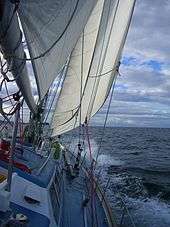
Seamanship has been a main part of the curriculum since the school began. The first voyage of note was in a cutter from Hopeman to Dornoch in June 1935, a distance of 25 miles (40 km).[45] Pupils still train in cutters from the age of 13 upward at Hopeman Harbour to prepare for a voyage in the school's 80 ft (24 m) sailing vessel. Most excursions take a week sailing off the West Coast of Scotland, but the school also enters into the Tall Ships' Races annually which allows pupils to take part in an international competition in European waters lasting up to a month.[46]
Prefects
In the lower school, ages 13 to 16, a boy and a girl in the sixth form (ages 16 to 18) are elected to be Captains of the lower school. They provide liaison between teachers and pupils so that any concerns can be rectified. Other roles can include organising inter-house activities, charitable events and the lower school social ("social" refers to social event or party).[47]
In the Upper School, ages 16 to 18, responsibility is available through a hierarchy of positions.[32] This starts with Captains of Sports, Service and House. In the case of Captains, no peer voting takes place, but rather a pupil is elected by the Head of the respective department. This way it is not uncommon for some people to be re-elected as Captain for multiple terms depending on whether or not anybody else of suitable stance is available. Captains of Sport such as the Football or Rugby Captain are chosen by the Head of that sport and will help the Head organise teams for practice and preparation off the field of play as well as on it. Similarly, Captains of Service will aid the Head of Service to organise training sessions and be a point of contact for the rest of the members.[47]
Captains of House are slightly different though in that they play a more personal role for pupils who want to voice problems with conditions within the house and this often means that House Captains have a lot more pupils to be responsible for. This difference is more evident in their original title of 'Helper'.[48] They tend to be in close contact with the housemaster so that any issues requiring immediate attention can be sorted out as well as being able to relay any general ideas or concerns in the House Captains' Council which meet once every two weeks. At the meeting a teacher is present, and minutes are taken so that they can be passed onto the Colour Bearers (CBs).
Colour Bearers get their name from a band of purple they wear as insignia on their uniform, purple being one of the school's colours. They are elected by the pupils and the staff, similar to Eton's Pop,[49] and have non-important roles in the school community as a whole.[50] Unlike captains they keep their positions for a whole year unless they are demoted as a punishment for untoward behaviour. They meet every week with the Headmaster to attend to a wide range of school matters. As well as this they are responsible for minor roles which would otherwise be taken up by teaching staff such as (hence the nickname teachers pet given to CB's), maintaining the refectory and the library and for serving drinks behind the bar at the weekly socials in addition to organising major school wide events that take place throughout the year.[47]
From the CBs a boy and a girl are chosen to be Guardians for the academic term. These are the Head Pupils for the entire school and only normally 6 people a year are allowed to have this position. The term Guardian comes from the name of the supportive rulers of Plato's ideal state.[51] Like the staff, they are closely involved in the management and well-being of the school.
Boarding houses
There are seven boarding houses ranging from year 9-13, one sixth-form house, nine including the one no longer in operation, on the campus. The houses are run by a small team of teachers. The House Master (HM) has overall responsibility and is helped by the Assistant House Master (AHM). Either or both of these will be present at the daily house meeting and will oversee homework[c] to make sure pupils are studying. The HM will organise any special house events, decide who the house captain will be for the term as well as choosing a captain to take care of other house related activities. The HM is also the person who most pupils would talk to if they had a problem although all teachers are available for help. Both the HM and the AHM normally have residences within the houses and so are very much part of the house. Each house has a matron who helps the pupils through their daily routine as well as a tutor to help the pupils in their studies.[52] The year a pupil is in, and the amount of rooms in the house decides which pupils are allowed a room of their own, although it is normally decided that younger years share whilst senior pupils get their own rooms. All pupils rotate rooms each term.
The houses are:
Female
- Hopeman House
- Plewlands House
- Windmill Lodge
Male
- Altyre House (pre-2016)
- Bruce House
- Cumming House
- Duffus House
- Gordonstoun House (G-House; sixth-form only) (pre-2018)
- Round Square
Some houses will go on house expeditions and there are many inter-house competitions that take place in the year. These competitions vary. The most common are sports such as basketball and football or simply a tug of war. All of the boarding houses throw a themed party annually, and pupils may invite guests from other houses.[53]
Old Gordonstounians
For OGs there is the Gordonstoun Association which aims to promote and strengthen links between former pupils of the school and the school itself. The patron of the GA is the Duke of Edinburgh.
British Royal Family
During the 1960s Prince Charles attended the school on the recommendation of his father, Prince Philip, Duke of Edinburgh, who had been one of the first pupils to attend Gordonstoun, having previously been educated at Salem in Germany. Prince Charles did not enjoy the regime which he later characterised as "Colditz in kilts".[54] Princes Andrew and Edward followed in their father's and elder brother's footsteps. Of the four princes, three (Philip, Charles and Edward) were appointed Guardian (Head Boy) during their time at the school.[55] Princess Anne, Philip's only daughter, was not educated at Gordonstoun, which at that time was for boys only, but she sent her two children, Zara and Peter, while also serving for some time on the school's board of governors.[56]
Royalty and aristocrats
- Alexander, Crown Prince of Yugoslavia
- Prince Philip, Duke of Edinburgh
- Charles, Prince of Wales
- Prince Andrew, Duke of York
- Prince Edward, Earl of Wessex
- Peter Phillips
- Zara Phillips
- Nicholas Alexander, 7th Earl of Caledon
- James Carnegie, 3rd Duke of Fife
- Alexander Douglas-Hamilton, 16th Duke of Hamilton
- Jasper Duncombe, 7th Baron Feversham
- Christopher Finch-Hatton, 16th Earl of Winchilsea
- Granville Gordon, 13th Marquess of Huntly
- John Grant, 13th Earl of Dysart
- Paul-Philippe Hohenzollern
- Norton Knatchbull, 3rd Earl Mountbatten of Burma
- Angus Montagu, 12th Duke of Manchester
- Lord Ivar Mountbatten
- Michael Pearson, 4th Viscount Cowdray
Other OGs
Other OGs are listed in List of people educated at Gordonstoun.
In addition to the royal family other notable alumni include:
- Stuart Agnew – Former UK Independence Party MEP
- William Boyd – writer
- Oona Chaplin – actress
- Jason Connery – actor
- Balthazar Getty – actor and heir to the Getty oil fortune
- Dick Heckstall-Smith – musician
- Caroline Johnson – Conservative Member of Parliament
- Duncan Jones (formerly known as Zowie Bowie) – film director and son of musician David Bowie
- Luca Prodan – musician
- Lara Breay - film producer
- Heather Stanning – rower, Olympic gold medallist at London 2012 with Helen Glover
- Roy Williamson – musician, member of the Corries, writer of Flower of Scotland,[57] one of several unofficial Scottish national anthems and possibly the most popular.
Fictional graduate
Gordonstoun also has a notable fictional alumna: the heroine of Tomb Raider, Lady Lara Croft, was supposed to have attended the school in sixth year; she has also been used to advertise it.[58][59]
Controversies
In 2002, the school barred two former pupils who had published an article about the headmaster's daughter.[60] This was after the Headmaster, Mark Pyper, had banned his daughter, a pupil there, from all social activities in the grounds for two weeks after she had been caught drinking alcohol in the school grounds.[61]
In 2010, a teacher was struck off, or had their teaching licence/qualification revoked, by the General Teaching Council for Scotland for warning students about exam content in advance of the tests.[62]
In 2017, Gordonstoun was named as one of the schools being investigated in the Scottish child abuse inquiry chaired by Lady Smith.[63]
In 2018, ex-teacher Andrew Keir was convicted of offences including indecent assault involving 13-year-old pupils at the school between 1988 and 1991. He was subsequently jailed for 12 months.[64]
See also
- Broneirion, Gordonstoun's home during World War II
Notes
- ^ a: Gordonstoun has different names for different segments of the school. The Junior School refers to the prep school, Aberlour House (ages 8 to 13) and the Senior School refer to Gordonstoun itself (ages 13–18). In addition, the Senior School is split into the Lower School (ages 13 to 16) and the Upper School (ages 16 to 18)
- ^ b: In sports such as football and cricket, there are 11 players, and so the best team is often referred to as the First XI. Other sports have the similar terms; e.g., rugby union has the 1st XV, etc.
- ^ c: A 'prep school' in the UK is an independent school for children of (usually) ages 8 to 13. It is an abbreviation of preparatory school, intended to prepare students for secondary school – known as a Public School if in the independent sector. 'Prep' is also a term in British boarding schools that means homework. It comes from the term "preparatory work", as in work done to prepare for the next lesson in the relevant subject.
[65]
References
- "Gordonstoun Manor History". 2004. Archived from the original on 12 July 2011. Retrieved 31 March 2010.
- "Which Schools: Gordonstoun Details". Which School Ltd. Archived from the original on 12 March 2010. Retrieved 31 March 2010.
- Graeme Paton (8 September 2009). "UK Class Sizes". The Telegraph. London. Retrieved 4 April 2010.
- "Gordonstoun: Employment". Gordonstoun. 2009. Archived from the original on 17 April 2010. Retrieved 31 March 2010.
- "School merger for Gordonstoun". BBC News. 15 March 2002. Retrieved 4 April 2010.
- Jocelin Young (1 October 1992). "Round Square: Who We Are". Archived from the original on 20 July 2011. Retrieved 4 April 2010.
- Brereton 1950. p29
- Röhrs 1970. p. xix
- Röhrs 1970. p. 22
- Röhrs 1970. p. xx
- "Costa Rica Rainforest Outward Bound School: History". Costa Rica Rainforest Outward Bound School. 2009. Archived from the original on 27 March 2010. Retrieved 4 April 2010.
- Attwood, Gertrude (1988). The Wilsons of Tranby Croft. London: Hutton Press. p. 117. ISBN 978-0-907033-71-4.CS1 maint: ref=harv (link)
- Arnold-Brown 1962. p. 3
- Brereton 1950. p. 29-30
- Brereton 1950. p. 33
- "History". Outward Bound International. Retrieved 12 October 2018.
- Outward Bound International (2004). Birth of Outward Bound Archived 2007-11-10 at the Wayback Machine. Retrieved 9 December 2007.
- Brereton 1950. p. 34-35
- Röhrs 1970. p. 50
- Brereton 1950. p. 54
- Brereton 1950. p. 49
- Brereton 1950. p. 48-49
- Röhrs 1970. p. 58
- Emma Daly (14 June 1996). "Old School..." The Independent. London. Retrieved 8 April 2010.
- "Aberlour History". HBC-SU. 24 December 2004. Retrieved 9 April 2010.
- Röhrs 1970. p. 45-46
- John Ross (28 April 2009). "Gordonstoun turns back clock". The Scotsman. Retrieved 4 April 2010.
- Ben Russell (4 December 1999). "G-stoun Softens Image". The Independent. London. Retrieved 9 April 2010.
- Stephen McGinty (24 February 2010). "New Headmaster for G-stoun". The Scotsman. Retrieved 4 April 2010.
- "G-stoun Profile". Metropolis International Group Ltd. Archived from the original on 17 July 2011. Retrieved 5 April 2010.
- Brereton 1950. p. 11
- "Independent Schools Guide". Guidetoindependentschools.com. Archived from the original on 11 July 2011. Retrieved 5 April 2010.
- "Gordonstoun School: Scholarships". Gordonstoun. 2009. Archived from the original on 10 April 2010. Retrieved 4 April 2010.
- "Gordonstoun School: Aims". Archived from the original on 29 March 2010. Retrieved 31 March 2010.
- "Aberlour Info". Prospects Services Ltd. 2010. Archived from the original on 16 April 2009. Retrieved 9 April 2010.
- "GISS Info 1". MacGregor Education Services Ltd. 2010. Archived from the original on 22 April 2010. Retrieved 9 April 2010.
- "GISS Info 2". S W Crawford. 2000. Retrieved 9 April 2010.
- "Education Scotland". Education Scotland.
- "HMIE Report PDF file" (PDF). HM Inspectorate of Education. 9 June 2009. Archived from the original (PDF) on 2 March 2012. Retrieved 4 April 2010.
- Arnold-Brown 1962. p. 28
- Arnold-Brown 1962. p. 29
- "Gabbitas Education: Facilities". Gabbitas Education. Archived from the original on 31 July 2010. Retrieved 31 March 2010.
- "Gordonstoun School: Football". Gordonstoun. 2009. Archived from the original on 23 December 2009. Retrieved 4 April 2010.
- "Station 39". BTinternet. Archived from the original on 23 October 2012. Retrieved 8 April 2010.
- Arnold-Brown 1962. p.30
- "Tallships". /tallships.ru. 2008. Archived from the original on 30 August 2011. Retrieved 8 April 2010.
- "Gordonstoun School: Responsibility". Gordonstoun. 2009. Archived from the original on 23 December 2009. Retrieved 4 April 2010.
- Arnold-Brown 1962. p30
- Brereton 1950. p 18.
- Brereton 1950. p17.
- Arnold-Brown 1962. p.35
- "Gordonstoun School: Pastoral Team". Gordonstoun. 2009. Retrieved 4 April 2010.
- "Gordonstoun School: Houses". Gordonstoun. 2009. Retrieved 4 April 2010.
- Victoria, Bone. "In pictures: Prince Charles turns 60". BBC. Retrieved 11 April 2010.
- "Biography Online: Prince Charles". Retrieved 4 April 2010.
- John Staples (8 July 2002). "The Scotsman: Princess Anne campaigns for Gordonstoun". Retrieved 4 April 2010.
- The Corries website Archived 29 August 2010 at the Wayback Machine www.corries.com Retrieved 12 July 2008
- "Lara's school days on big screen". BBC News. 2 July 2001.
- Hibbard, Andrew (2 July 2001). "Lara Croft offers Gordonstoun a lift". The Independent. London.
- "Gordonstoun bars two old boys School anger over magazine article on head's daughter". HeraldScotland. Retrieved 4 July 2019.
- "Old boys banned from Gordonstoun". www.scotsman.com. Retrieved 4 July 2019.
- "Archived copy". Archived from the original on 28 May 2015. Retrieved 28 May 2015.CS1 maint: archived copy as title (link)
- "Top private schools included as part of Scottish child abuse inquiry". The Guardian. 31 January 2017.
- "Disgraced housemaster found guilty of grooming pupils at top Scots school used by royals and rich". Daily Record. 9 March 2018.
- "Google Definitions". Google. Retrieved 25 May 2010.
Works cited
- Brereton, H.L. (1950). Gordonstoun. The University Press Aberdeen.
- Röhrs, Hermann (1970). Kurt Hahn. London: Routledge & Kegan Paul. ISBN 0-7100-6885-9.
- Arnold-Brown, Adam (1962). Unfolding Character: The Impact of Gordonstoun. London: Routledge & Kegan Paul.